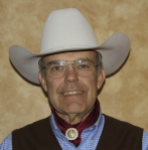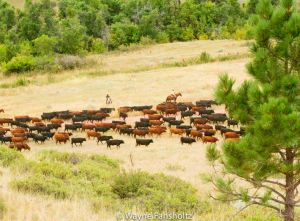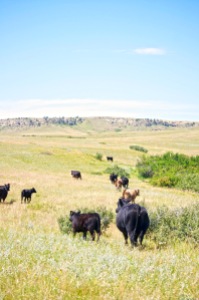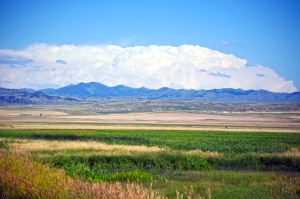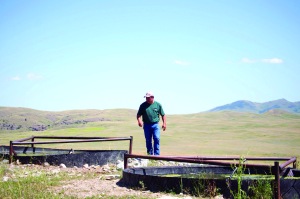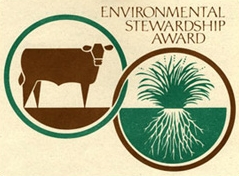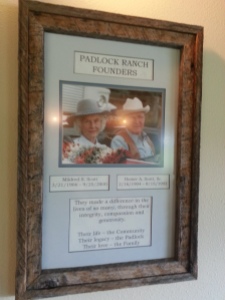Montana ranching family honored with Environmental Stewardship Award for enduring efforts to care for water, wildlife, soil and ranching business.

“I hope they slow down every once in a while,” Chuck Hahn says, nodding at the steady line of boaters, anglers and campers streaming north to Canyon Ferry Lake.
He’s not talking about their speedometers, either.
“I just see people so rushed,” he says. “If they’d just take the time to slow down, look, observe, take what they see here into consideration, they’d see: this all interacts together, and we’re all here to try and make things better.”
While a 360-degree view of their Townsend, Montana ranch could probably flash through his mind in a millisecond of memories, the scope wouldn’t fit in a passenger window at 65 mph.
To the south, Deep Creek meanders west to its end in the Missouri River. It cuts its path from the east through the Big Belt Mountains, providing water for Blue-Ribbon fisheries, essential crop irrigation, recreation and stock water along the way. The gently sloping Elkhorn Mountain rise up to the west, where, thanks to conservation efforts in recent decades, the mountain island lives up to its name as a wildlife destination. There, the Hahn family’s cattle graze on the rangeland that holds its ground as open space buffering the public land from the subdivisions sprawled through the valley.
Standing in their irrigated pasture in the middle of it all, Chuck pulls the bill of his ball cap down a little. He squints at the sun bearing down on this landscape his family has known through every season for more than 100 years. Above all else, he says, he hopes the passengers speeding by on the busy highway see the same thing he sees here: patience.
 He hopes they understand the patience it takes to see conservation efforts pay off beyond the ranch and their personal bottom line; patience to witness the tenacity of his father and grandfather touch his sons and nephews’ desire to care for the land for future generations; patience for one short lifetime of work to preserve resources timelessly treasured by ranchers, recreational users, hunters & anglers alike.
He hopes they understand the patience it takes to see conservation efforts pay off beyond the ranch and their personal bottom line; patience to witness the tenacity of his father and grandfather touch his sons and nephews’ desire to care for the land for future generations; patience for one short lifetime of work to preserve resources timelessly treasured by ranchers, recreational users, hunters & anglers alike.
“The thing this family really understands is the kind of give and take that goes into the bigger picture,” Denise Thompson says. “They understand there are going to be sacrifices, but the overall benefit and reward of these efforts outweigh the sacrifices.”
The Broadwater County Conservation District administrator helped recommend the Hahn Ranch as the 2018 Montana Environmental Stewardship Award winners. The award recognizes cattle ranchers who are exemplary stewards of the land, livestock, wildlife and natural resources. In addition to cattle, the diverse family ranch supports hay, small grains and forage crop farming, a trucking company, and a pheasant hunting enterprise. The multi-generational team included Chuck, his sons Dusty and Buck, his brother John Hahn, sister Bev Bird, her son Cory and his wife Jennilee and matriarch Dorothy Hahn.
The ranch was also nominated by collaborators with the Montana Fish, Wildlife and Parks (FWP) for their partnership on projects that have benefited fisheries and water quality on the ranch and for downstream users. But their conservation practices stretch far beyond the creek beds of the southwestern Montana ranch.
Ron Spoon, a FWP fish biologist, has worked with the Hahn family since 1990.
“Folks that collaborate with Chuck know he thoroughly protects the function of the ranching operation, but they know he also genuinely pushes for solutions that benefit resources beyond the ranch,” Spoon says.
DEEP VALUES ON DEEP CREEK
 “This really is the lifeblood to our main farming and ranching operation here, along with the Missouri River itself,” Dusty says, standing in the nearly waist-high grass on the banks of Deep Creek. Between 1,000 and 3,000 brown trout annually migrate out of Deep Creek into the Missouri River. The waterway also provides irrigation and some stock water on the Hahn Ranch.
“This really is the lifeblood to our main farming and ranching operation here, along with the Missouri River itself,” Dusty says, standing in the nearly waist-high grass on the banks of Deep Creek. Between 1,000 and 3,000 brown trout annually migrate out of Deep Creek into the Missouri River. The waterway also provides irrigation and some stock water on the Hahn Ranch.
They’ve been working in partnership with the FWP, Natural Resources and Conservation Services (NRCS), Department of Natural Resources and Conservation (DNRC), their local conservation district and other water users in the valley for nearly 30 years to improve the creek and re-establish it as a free-flowing tributary to the Missouri River.
In 1991, they were a part of the first of many efforts to get Deep Creek off the state Department of Environmental Quality’s (DEQ) list of impaired waters. The installation of the Montana Ditch siphon was one major step to restoring Deep Creek’s function as a nursery too and cold water refuge on this blue ribbon fishery.
“As we become more conservation-minded all the time, we’re working harder and harder to improve water quality and water flow rates,” Dusty says. “That means we’re able to leave a little something more for downstream, and it’s of a higher quality. That’s just the right thing to do.”
Back when they started in 1991, there was an average of less than 10 brown trout spawning redds at many locations along the creek. In 2016, one location on the Hahn Ranch noted as many as 75 redds. More recent projects to relocate irrigation diversions and pumping have now tripled streamflow in a commonly dewatered reach of Deep Creek. All streams naturally increase in water temperature as water travels downstream, Spoon explains. Deep Creek used to warm up by 8 degrees Fahrenheit in the lower 13 miles of stream but now warms by 2.5 degrees as a result of changes in irrigation practices.
“Water is probably one of the most precious resources, especially in the West,” Dusty says. “So anything that we can do to conserve and enhance that resource, we’re interested in. It helps everybody along the watershed of the Missouri and ultimately that drains into the Mississippi, and that’s important for us as agriculturalists.”
 Clean, cold, connected waters with healthy fisheries indicate a healthy watershed, which is a nod to those who manage the land and livestock around it, Spoon says: “Chuck and his family provide a valuable example of how a long-term ranching operation can simultaneously create agricultural products and foster clean water.”
Clean, cold, connected waters with healthy fisheries indicate a healthy watershed, which is a nod to those who manage the land and livestock around it, Spoon says: “Chuck and his family provide a valuable example of how a long-term ranching operation can simultaneously create agricultural products and foster clean water.”
The Hahns are quick to point out it’s a nod to the entire community.
“To enhance the watershed, you’ve got to be able to pull all the pieces together. It takes everyone in the valley,” Chuck says. “It’s one of those things that just won’t happen without all the right people involved.”
He points back to the conservation district and FWP leaders they worked with, and the other landowners who came forward with the same patience to work through 25 years of negotiations and hard work to see an entire watershed blossom. It was recently the first of its kind to be removed from the DEQ’s “Total Maximum Daily Load” listing thanks to its plan to reduce nonpoint source sediment pollution.
“Seeing that watershed thriving; that’s been a real bright spot in my lifetime,” Chuck says. “Water is such an important thing in these valleys, especially to us as irrigators. But to work with the general public through some of these programs so we can maintain our water and still add some benefit for recreation, too – that’s good for everybody.”
OVERTAKEN, BUT NOT OVERWHELMED
 Devastating.
Devastating.
That’s one way to describe the events caused by the wave of floodwater in the valley in the 1950s. Canyon Ferry Lake was formed with the completion of the Canyon Ferry Dam in 1954. It flooded the small town of Canton and 37 ranches along the Missouri River, including the 1,100 acres Chuck’s grandfather, Stephen Arnold Douglas Hahn, had established in 1908.
Today, the recreation destination is the third largest body of water in Montana and the source of much of the traffic that passes by on the busy Highway 287. Chuck’s parents, Paul and Dorothy, purchased a fresh 347 acres after the original ranch was condemned, and they started over with the same determination and optimism that prevails in the current generation.
“To say that was a devastating time for many ranchers in the valley would be an understatement,” Thompson says. “But somehow, they made it a positive and came out stronger.”
Half a century later, the family saw another man-made surge threatening the area.
“This valley has grown so fast because we’re so close to population areas and it’s an attractive area for recreation,” Chuck says.
Subdivision and development were sprawling out from the lake and surrounding areas, threatening grazing lands and cherished open landscapes.
“We’re working to utilize the resources that are available to us while maintaining this environment,” Dusty says. “Part of that is just preserving open spaces, and maintaining that for agricultural purposes.”
In 1998, the ranch enrolled in Broadwater County’s first conservation easement with the FWP to maintain 1,680 acres for agricultural purposes in perpetuity. The land sits next to the nationally unique Elkhorn Wildlife Management Unit and now provides a critical link between blocks of federal land to prevent further urban development.
“If we’re not able to have a viable land base for livestock grazing, we’re going to be seeing a lot more of these arid landscapes being put into development,” Chuck says. “So the easement keeps those areas open, and it gives us a chance to have our grazing.”
The easement allowed the ranch to expand a more efficient rest-rotational grazing system between their private and publicly leased ground, while also providing financial flexibility for expansion, allowing more family members to have a place on the ranch.
GRAZING FOR DIVERSITY ABOVE AND BELOW GROUND
 “When we’re up there gathering the cattle, we find elk in the same area as the cattle,” Dusty says. “They tend to follow them around and graze the regrowth that the cattle had grazed down, so it’s definitely a mutually beneficial relationship.”
“When we’re up there gathering the cattle, we find elk in the same area as the cattle,” Dusty says. “They tend to follow them around and graze the regrowth that the cattle had grazed down, so it’s definitely a mutually beneficial relationship.”
They’ve been enrolled in the Block Management Program for nearly 25 years, where each year, the FWP estimates 900 hunter days are recorded on the Hahn Ranch to pursue elk, mule deer, pronghorn antelope, white-tailed deer, black bear, mountain lion and upland bird.
“This wide diversity of wildlife indicates how well the land and vegetative communities occurring on the Hahn Ranch are being managed as a whole,” FWP Conservation Technician Fred Jakubowski says.
It’s a part of their Montana heritage they want to see through to future generations, too, Dusty says: “I grew up hunting and fishing, and we like the opportunity, for kids especially, to do that and have a good experience at it.”
The family has further diversified by raising pheasants and offering a shooting preserve.
“It’s nice to be able to share a little of this open space with people who aren’t so lucky to have that every day. By allowing hunters to come out and see our operation, we hope it helps educate people as to what we’re doing and how things work,” Chuck says. “Hopefully, that interaction between us and them gives them a much brighter picture of the agriculture operations around the state.”
 They’ve adapted their farming practices to take care of the biodiversity underground, too. They grow both cash crops and forage crops to extend their grazing season, allow for longer rest periods on the rangeland and enhance the health of their farmed soil. After hay barley is baled, a combination of radishes and turnips are planted to burrow into the ground and break up soil compaction. In other rotations or fields, legumes like peas are planted to naturally add nitrogen back into the soil. In both scenarios, incorporating cattle grazing into the cropping system is essential to its success.
They’ve adapted their farming practices to take care of the biodiversity underground, too. They grow both cash crops and forage crops to extend their grazing season, allow for longer rest periods on the rangeland and enhance the health of their farmed soil. After hay barley is baled, a combination of radishes and turnips are planted to burrow into the ground and break up soil compaction. In other rotations or fields, legumes like peas are planted to naturally add nitrogen back into the soil. In both scenarios, incorporating cattle grazing into the cropping system is essential to its success.
“By using cover crops and no-till to enhance the soil health, we’re able to keep the soil organisms alive as long as we can during the year,” Chuck says. “The livestock are there to help incorporate that plant mass back into the soil. It’s just really interesting to go out and dig up a shovel full of that dirt, look at it and see all the differences in the soil structure from when we were turning the soil every year.”
They conduct soil tests on farmland each year to monitor organic matter and determine the precise amount of fertilizer needed to not only reduce inputs but to prevent over-saturation that could cause runoff.
In the years they’ve been monitoring organic matter in their farmed soil, it’s moved from an average of three percent to closer to five percent. According to the Montana Department of Environmental Quality, native grassland range in the state is typically comprised of about four percent organic matter.
This too goes beyond the borders of the ranch. Jim Beck, the association supervisor at the Broadwater Conservation District, works with Chuck on the management of public lands, where he’s eager to share ideas about improving soil health and wildlife habitat there, too.
“He’s helped us with soil health and transforming non-productive land into productive land, and then into agriculturally productive land as well,” Beck said. “He’s often able to extend the scope of those improvements to include other producers and community interests, too.”
That just takes time, no matter how quickly the world turns.
“Longevity is what makes an impact,” Thompson says. “It’s folks who are willing to hunker in for the long haul and build relationships with agencies or partners or different landowners who get things done; short-term work doesn’t get big picture things done.”
That big picture can easily be missed flying by at 65 mph, but not when Mother Nature dictates the speed of reaping what you sow. In her world, patience takes the lead.
“It’s what I’ve relied on my whole life, to be patient, to be steady. You’re always trying to swing for that home run, but you rarely hit it,” Chuck smiles. “So instead, you hit singles and keep loading the bases, keep things coming in and getting a little better one step at a time. Patience is just knowing what we look around and see here took millions of years, and we’re just a snap of a finger in it all.”
Watch a video about the Hahn Ranch.
Find out more about the Environmental Stewardship Award.




 He hopes they understand the patience it takes to see conservation efforts pay off beyond the ranch and their personal bottom line; patience to witness the tenacity of his father and grandfather touch his sons and nephews’ desire to care for the land for future generations; patience for one short lifetime of work to preserve resources timelessly treasured by ranchers, recreational users, hunters & anglers alike.
He hopes they understand the patience it takes to see conservation efforts pay off beyond the ranch and their personal bottom line; patience to witness the tenacity of his father and grandfather touch his sons and nephews’ desire to care for the land for future generations; patience for one short lifetime of work to preserve resources timelessly treasured by ranchers, recreational users, hunters & anglers alike. “This really is the lifeblood to our main farming and ranching operation here, along with the Missouri River itself,” Dusty says, standing in the nearly waist-high grass on the banks of Deep Creek. Between 1,000 and 3,000 brown trout annually migrate out of Deep Creek into the Missouri River. The waterway also provides irrigation and some stock water on the Hahn Ranch.
“This really is the lifeblood to our main farming and ranching operation here, along with the Missouri River itself,” Dusty says, standing in the nearly waist-high grass on the banks of Deep Creek. Between 1,000 and 3,000 brown trout annually migrate out of Deep Creek into the Missouri River. The waterway also provides irrigation and some stock water on the Hahn Ranch. Clean, cold, connected waters with healthy fisheries indicate a healthy watershed, which is a nod to those who manage the land and livestock around it, Spoon says: “Chuck and his family provide a valuable example of how a long-term ranching operation can simultaneously create agricultural products and foster clean water.”
Clean, cold, connected waters with healthy fisheries indicate a healthy watershed, which is a nod to those who manage the land and livestock around it, Spoon says: “Chuck and his family provide a valuable example of how a long-term ranching operation can simultaneously create agricultural products and foster clean water.” Devastating.
Devastating. “When we’re up there gathering the cattle, we find elk in the same area as the cattle,” Dusty says. “They tend to follow them around and graze the regrowth that the cattle had grazed down, so it’s definitely a mutually beneficial relationship.”
“When we’re up there gathering the cattle, we find elk in the same area as the cattle,” Dusty says. “They tend to follow them around and graze the regrowth that the cattle had grazed down, so it’s definitely a mutually beneficial relationship.” They’ve adapted their farming practices to take care of the biodiversity underground, too. They grow both cash crops and forage crops to extend their grazing season, allow for longer rest periods on the rangeland and enhance the health of their farmed soil. After hay barley is baled, a combination of radishes and turnips are planted to burrow into the ground and break up soil compaction. In other rotations or fields, legumes like peas are planted to naturally add nitrogen back into the soil. In both scenarios, incorporating cattle grazing into the cropping system is essential to its success.
They’ve adapted their farming practices to take care of the biodiversity underground, too. They grow both cash crops and forage crops to extend their grazing season, allow for longer rest periods on the rangeland and enhance the health of their farmed soil. After hay barley is baled, a combination of radishes and turnips are planted to burrow into the ground and break up soil compaction. In other rotations or fields, legumes like peas are planted to naturally add nitrogen back into the soil. In both scenarios, incorporating cattle grazing into the cropping system is essential to its success.



 As recipient of this year’s Montana ESAP recognition, the American Fork will submit an application this month for the regional ESAP awards, to be announced in July 2015. Throughout 2015, Montana Stockgrowers will continue to share more about the American Fork Ranch, the Stevens and Evjene families, and their work as examples of Environmental Stewardship within the Montana ranching community.
As recipient of this year’s Montana ESAP recognition, the American Fork will submit an application this month for the regional ESAP awards, to be announced in July 2015. Throughout 2015, Montana Stockgrowers will continue to share more about the American Fork Ranch, the Stevens and Evjene families, and their work as examples of Environmental Stewardship within the Montana ranching community.
